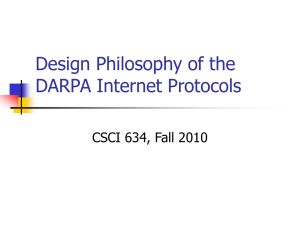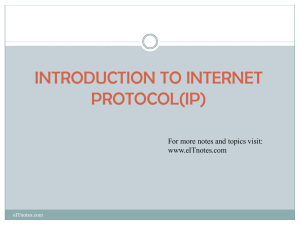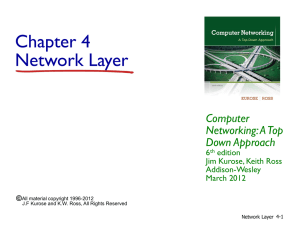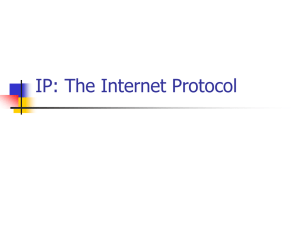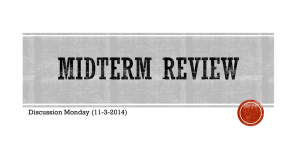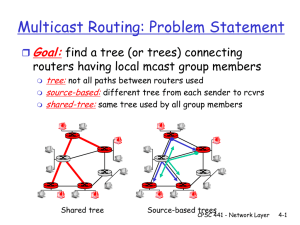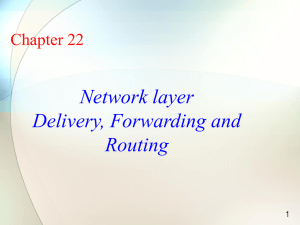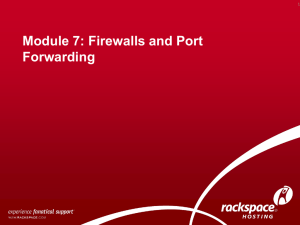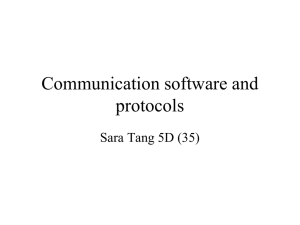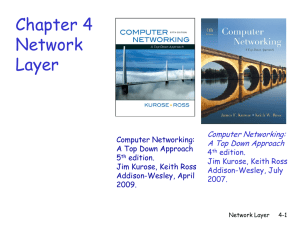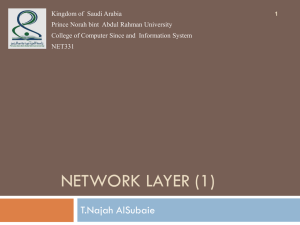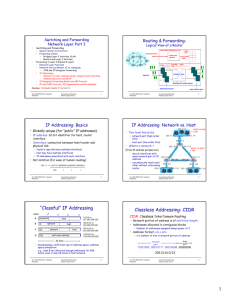Chapter 7
advertisement
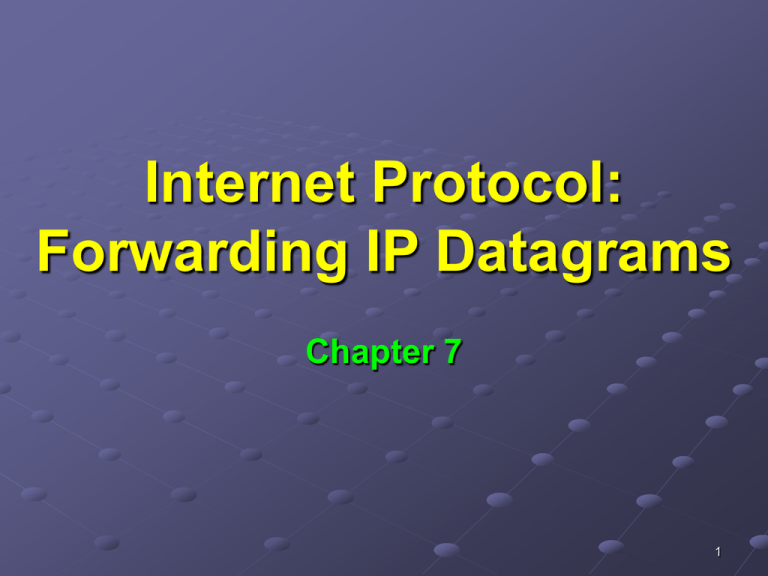
Internet Protocol: Forwarding IP Datagrams Chapter 7 1 Basic unit of transfer in TCP/IP internet is the datagram Datagram format characterizes the static aspects of IP Forwarding characterizes the operational aspects 2 Forwarding In An Internet Forwarding refers to choosing a path for packets Term routing was previously used Popular term now is forwarding Router is the computer making the choice WAN Has multiple physical connections between packet switches Network itself routes packets while in net Internal routing; self-contained in the WAN 3 Goal of IP: Virtual network Focus on IP forwarding Also called internet routing or IP routing Information used to make decisions called IP forwarding information Similar to forwarding in single physical network: IP forwarding chooses path for datagram Difference Chooses routes across multiple physical networks 4 Forwarding can be difficult Ideally, should be based on: Network load Datagram length Type of service specified Most software is less sophisticated Selects on fixed assumptions about shortest paths Both hosts and routers participate Host may make initial forwarding decision if has access to multiple routers (even if singlyhomed) Also, multi-homed hosts & general machines For now, treat hosts and routers separate 5 Direct and Indirect Delivery Can divide forwarding into two forms: Direct Delivery Datagram from one machine to another Across single physical network Both must be attached to same physical network Indirect Delivery Destination not on a directly attached network Router must become involved 6 Delivery over a single network IP datagram encapsulated into frame IP address mapped to physical address Network hardware delivers the datagram To tell if destination directly connected: Easy based on prefix and suffix of IP address Sender extracts network prefix of destination If same as its network portion: directly connected Special case of general purpose forwarding Final router always directly connected to destination 7 Indirect delivery Sender must specify a router Router must then forward toward destination Datagram passes from router to router until it reaches a router directly connected to destination Questions: How does a router know where to send a datagram? How can a host know which router to use? Consider basic table-driven forwarding now Later talk about routers learning new routes 8 Table-Driven IP Routing Uses IP routing table Info about destinations & how to reach them Both hosts and routers have What info to keep? Can’t do all possible destinations Couldn’t keep current; too much storage space IP address scheme helps Direct delivery test is efficient Routing tables only need network prefixes 9 Next-Hop Forwarding Routing table has pairs (N,R) N is the IP address of a destination network R is the IP address of the “next” router along the path to N R is the next hop Using this table is next-hop forwarding Don’t know whole path, only one step All routers in machine M’s table must be directly connected to M 10 10.0.0.0 30.0.0.7 Q 10.0.0.5 20.0.0.5 20.0.0. 0 S 30.0.0. 0 30.0.0.6 40.0.0.7 40.0.0. 0 R 20.0.0.6 To reach hosts on network Route to this address 20.0.0.0 Deliver Directly 30.0.0.0 Deliver Directly 10.0.0.0 20.0.0.5 40.0.0.0 30.0.0.7 11 Routing table size depends on number of networks Size & contents independent of number of hosts Consequences of choosing routes based on destination network ID alone: Traffic for same network usually take same path Multiple paths may not be used concurrently All traffic types follow same path regardless of delay or throughput Only final router knows if hosts exists or is operational Must report delivery problems Traffic from A-B may have different path than B-A 12 Default Routes If no route in table, use default route Keeps tables small Consolidates multiple entries into default case Useful when only one connection to internet Test if local net destination If not, only can go through one router anyway 13 Host-Specific Routes Forwarding based on networks, not individual hosts IP forwarding software allows per-host routes Gives local network admin more control over network use Permits testing Controls access for security purposes 14 IP Forwarding Algorithm ForwardDatagram(Datagram,RoutingTable) Extract destination IP address, D from datagram; If the table contains a host-specific route for D send datagram to next-hop specified in the table and quit; Compute N, the network prefix of address D; If N matches any directly connected network address deliver datagram to destination D over that network; (Involves resolving D to a physical address, encapsulating the datagram, and sending the frame.) Else if the table contains a route for network N send datagram to next-hop specified in table; Else if the table contains a default route send datagram to the default router specified in table; Else declare a forwarding error 15 Forwarding With IP Addresses IP forwarding does not alter original datagram Except for decrementing TTL and recomputing the checksum Source and destination addresses unchanged Router must pick next-hop IP address Where does this address get stored? There is no place in the datagram for it 16 Does not store the next-hop address at all IP passes datagram & next-hop address to the network interface Network interface software: Binds next-hop address to physical address Forms a frame using the physical address Places datagram in data portion of frame Sends the result Discards next-hop address 17 Why not use physical addresses when storing and computing routes? Routing table provides clean interface between IP forwarding SW and high-level SW Look at routing table to debug forwarding problems IP addresses makes it easy to do Point of IP is to build abstraction Communication software can be written to use internet addresses Only a few low-level routines need to know and interface with the physical addresses 18 Handling Incoming Datagrams When datagram arrives at a host: Network interface SW delivers incoming datagrams to IP module If destination address matches host’s: IP software accepts the datagram Passes it on to higher-level protocol software If destination address does not match host’s: Datagram must be discarded Hosts forbidden from trying to fix routing problem 19 When datagram arrives at a router: Delivered to IP module If destination IP address matches the routers: Datagram passed to higher-level protocol software Usually destined for router if testing or sending commands If datagram is not at final destination: TTL field is decremented If TTL = 0, datagram is discarded If TTL > 0, computes new checksum IP forwards the datagram using the forwarding algorithm 20 Determining if at final destination is not trivial Host may have multiple physical connections Destination IP address must be compared with that of each connection Also, may be a broadcast datagram Have to see if IP address matches the limited or directed broadcast IP address Classless, subnet, and multicast addresses make it even more complex Will see in later chapters…. 21 Why forbid hosts from forwarding functions? Host receiving datagram not for it indicates a problem Won’t be revealed if host takes corrective action Forwarding steals time from legitimate uses of the host Simple errors can cause chaos Some host accidentally broadcasts datagram for a host Every local host receive a copy; all send to recipient Routers do more than merely route traffic Report errors Propagate forwarding information 22 Establishing Routing Tables How do systems initialize routing tables? How are routing tables updated? Later chapters discuss the protocols that do this For now: Understand IP software uses routing tables to decide how to forward a datagram Changing routing tables will change the paths 23 Summary IP software forwards datagrams Decides where to send based on destination IP address Direct delivery used if the destination machine is on the same network as the sender Otherwise, sender must go through a router Datagrams travel from router to router until they can be delivered directly IP software produces IP address of the next hop Network interface SW encapsulates datagram, maps next-hop address to physical address, and sends 24 Internet forwarding algorithm: Is table-driven Uses only IP addresses Possible to have host-specific destination addresses Most routing tables only have network addresses Using default routes helps keep tables small Especially for hosts that can access only one router 25
